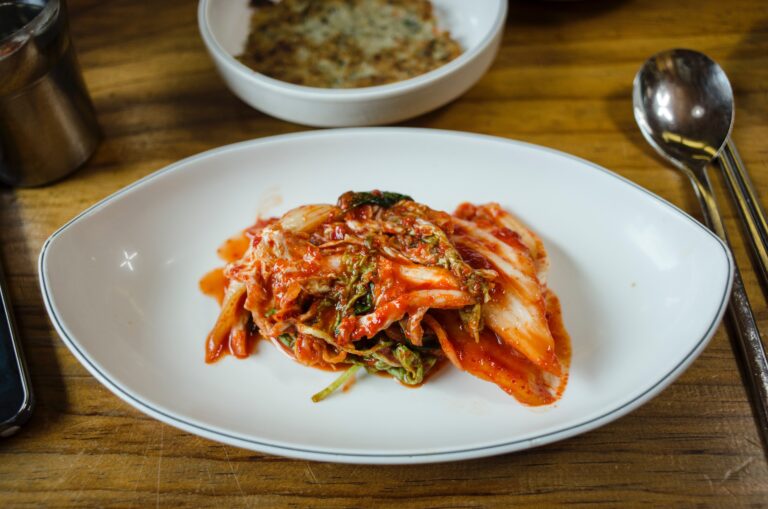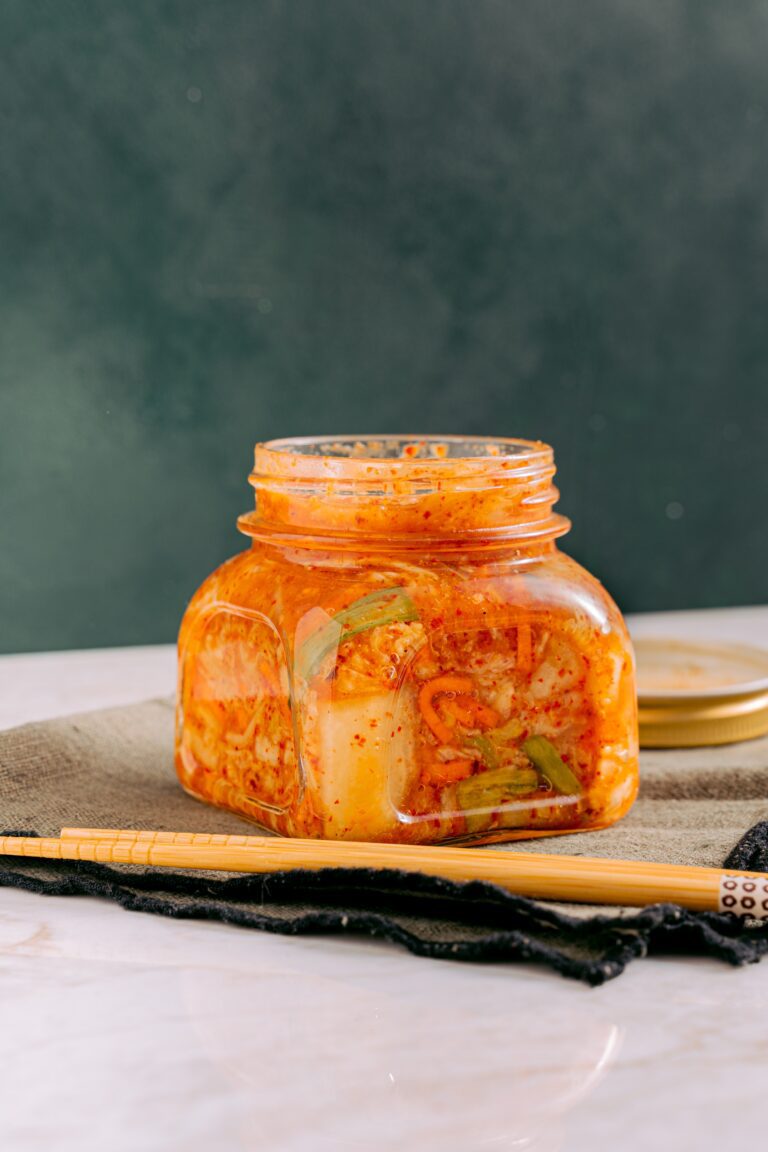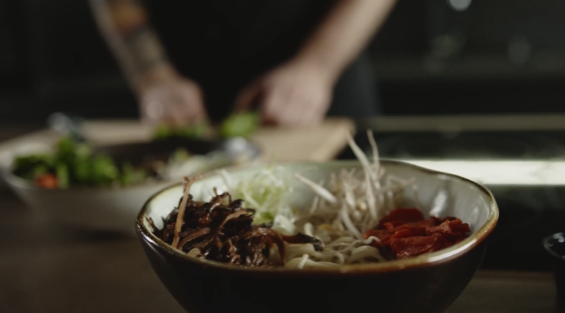
How To Make Vegan Baechu (Cabbage) Kimchi
Kimchi, is a traditional Korean side dish that is made of salted and fermented vegetables, such as napa cabbage , cucumbers and Korean radish. There is a wide selection of dishes in korean food with kimchi as the main ingredient as well as a wide range of seasonings that are used to prepare it, including gochugaru (Korean chili powder), gochujang (korean chilli paste), spring onions, garlic, ginger, etc. Kimchi is also used in a variety of soups and stews. As a staple food in Korean cuisine, it is eaten as a side dish with almost every Korean meal. Traditionally Kimchi also has jeotgal ( fermented sea food) in it . Kimchi has a slightly salty but tangy sour taste to it , and goes very well with ramen and rice etc . But one can make a lot of dishes with Kimchi as main ingredient as well , the range of foods you can make with kimchi is endless.

Kimchi not only is very delicious , but also has a large amount of health benefits , as it is very dense in nutrients and probiotics. Kimchi fermentation traditionally represents an efficient method of preserving the fresh and crispy texture of vegetables during winter, when fresh vegetables are not available. Actually, kimchi is a globally popular food, and its market size is gradually increasing. Thanks to the physiological effects of its ingredients and its microbial metabolites, kimchi is widely perceived as a health-promoting food. Plus with the increasing interest In Korean culture , many people wish to try this iconic dish from Korea . You can read more about the health benefits of Kimchi here
You can always buy kimchi from online outlets like amazon , or even from the nearby stores, but i prefer making it at home because it is both very easy to make and also when you make homemade kimchi , you can manage the taste by controlling the ingredients that go in your kimchi. By making it at home, we can change the ingredients as per our taste and also as per what suits our dietary requirement (e.g. seafood kimchi , vegetarian kimchi or vegan kimchi) as well.

Korean Food With Kimchi
There is a huge list of Korean dishes you can try making with Kimchi , some of them are as follows:
There are a lot of kimchi brands online , available on amazon and flipkart , even in physical stores , but in my opinion , the best kimchi is homemade , hence I am sharing my Kimchi recipe with you. This recipe is vegan and although a little time consuming , it is still very easy to make . I have also mentioned alternatives for items that you might not be able to find so that you can still try it.
The list of Ingredients that you will need to make baechu Kimchi are as follows –
- 1 Napa Cabbage (or 1 big Regular Cabbage)
- ½ cup salt
- 1 medium size onion
- 5-6 garlic cloves
- ½ inch ginger
- ½ red apple
- 1 tsp sugar
- 2 tbsp spicy chilli powder + 2 tbsp Kashmiri red chilli powder ( as replacement to Gochujang)
- 1 medium sized carrot
- 1 medium sized Korean radish ( I used normal white radish as I could not find korean radish)
- 1-2 spring onion
- 1 tsp soy sauce + 1 tsp vinegar ( as replacement to fish sauce)
- 2 tsp glutinous rice flour
- 1 tsp sesame oil
- 1 tsp sesame seeds


Steps to make baechu (Napa cabbage) Kimchi are as follows –
- Wash the cabbage 3-4 times and put aside in a bowl to dry
- Carefully remove the stem of the cabbage and then cut it into big chunks . You can instead take whole pieces of cabbage if you like it that way , I cut it into chunks to be able to eat easily.
- Put it in a bowl , to which you need to add ½ cup salt and set it aside for 2 hours , until the cabbage wilts . After it wilts, it should be able to bend easily without breaking and there will be some water separated from the cabbage after it is wilted.
- Now we need to wash this Cabbage atleast 3- 4 times , so that excess salt is removed from the cabbage and the brine does not get too salty.
- After the washing process , we need to prepare a spice mix for the cabbage to be made into kimchi.
- For this we need to take a red onion , along with 5-6 cloves of garlic , ½ inch piece of ginger and ½ red apple and blend it into a very smooth puree consistency
- Take it out in a big bowl and now we need to add 2 tbsp spicy chilli powder + 2 tbsp Kashmiri red chilli powder in it ( as replacement to Gochujang), 1 tsp soy sauce + 1 tsp vinegar ( as replacement to fish sauce) and 1 tsp sugar to it.
- Now we will need to take 2 tsp glutinous rice flour and mix it in ½ cup water .Place this on a pan and heat it until it becomes a paste like consistency , and then add it to the spice mix.
- Now add 1tsp sesame oil and sesame seeds to this mixture
- After this , finely Julienne 1 medium sized carrot, 1 medium sized radish ,1-2 spring onion and add this to the mix as well .
- Now add the cabbage to this mixture and coat the leaves well with the paste
- Keep the ready kimchi in a glass airtight bottle, and let it sit out for fermentation for about 24 hours . Once that is done , Your baechu kimchi is ready .Now you can store it in fridge , and it will remain good for atleast 2-3 months if kept in airtight container as mentioned and avoid using spoons that are wet in your kimchi.


Facts About Kimchi
Kimchi is the national food of South Korea, is a spicy pickled vegetable dish. Kimchi is traditionally made by combining cabbage, scallions, or radishes in a brine with garlic, ginger, chili pepper, and fish sauce, and allowing the ingredients to ferment. Kimchi has a rich history in South Korea dating back more than two thousand years.
Traditionally, kimchi is fermented in cool pits in the ground to help control the speed at which bacteria can grow. When its Properly made, kimchi can help preserve vegetables all year long. Kimchi is a crunchy, flavorful food that can provide impressive health benefits.
Health Benefits
The vitamins, minerals, and antioxidants in kimchi can provide important health benefits. Choline, which is found in kimchi, is a natural compound vital for maintaining your cells, your muscles, your nervous system, and even your mood. Choline is also important for maintaining your memory.
Kimchi is also rich in vitamin K, which helps your blood clot and keeps your bones from becoming brittle.
Some other health benefits of kimchi include:
Kimchi is a fermented food, which makes it an excellent probiotic. The same lactobacilli bacteria found in yogurt and other fermented dairy products are also found in kimchi. Consuming the so-called “good bacteria” in kimchi can help you maintain a healthy digestion.
Eating the probiotics found in fermented food can help reduce the negative symptoms of many gastrointestinal disorders, such as Irritable Bowel Syndrome and colon inflammation. Maintaining a healthy gut flora is important to your overall health.
Protect Your Heart
Probiotics have been shown to improve heart health by reducing cholesterol and inflammation. Studies show that kimchi can also reduce your risk of atherosclerosis through its antioxidant, anti-inflammatory, and cholesterol-lowering properties.
Immune System Support
Early research indicates kimchi may be able to strengthen your immune system. The bacteria that help ferment kimchi have been connected to improved immune function and lower levels of inflammation triggered by disease. The vitamin C found in kimchi can also help boost your immune health.
Nutrition
Kimchi is full of beta-carotene and other antioxidant compounds that can help reduce the risk of serious health conditions such as stroke, cancer, diabetes, and heart disease.
Kimchi is also an excellent source of:
- Vitamin A
- Vitamin C
- Vitamin K
- Folate
- Beta-carotene
- Choline
- Potassium
- Calcium
Nutrients per Serving
A one-cup serving of kimchi contains:
- Calories: 23
- Protein: 1 gram
- Fat: Less than 1 gram
- Carbohydrates: 4 grams
- Fiber: 2 grams
- Sugar: 2 grams
Kimchi’s status as a probiotic is helpful for many people, but it still contains live bacteria. The bacteria used to ferment kimchi are safe to consume. However, if kimchi is not properly prepared or stored, the fermentation process can cause food poisoning. As a result, people with compromised immune systems should take caution when eating kimchi or other fermented foods.
How to Prepare and Eat Kimchi
The most important part of making kimchi is keeping it at a cool, stable temperature to allow it to ferment before unwanted bacteria can grow. You can also buy kimchi at many grocery stores, Korean markets, and health food stores.
Kimchi can be eaten on its own, as a side dish, or as an ingredient in other foods. Its spicy, tangy flavor is an excellent complement to savory foods, and it’s often paired with rich dishes to add contrast to a meal.
Here are some ways to add kimchi to your diet:
- Mix kimchi into savory dishes like hash browns or potato pancakes.
- Use kimchi as a filling in an omelet.
- Make bibimbap with kimchi.
- Stir kimchi into homemade fried rice or any savory grain bowl.
- Add kimchi as an ingredient on your next sandwich.
I Hope You try this recipe and enjoy the same with your family and friends . Do Let me know if you have any feedback regarding the dish or suggestions related to the website.
Make sure to follow me on my social media platforms , instagram, Facebook and youtube Channel here , and subscribe to my newsletter.
Cabbage Kimchi

Cabbage Kimchi is really easy to make and adds a new taste to your ramyeon or rice.
Recipe Ingredients:
 LOADING
LOADING



